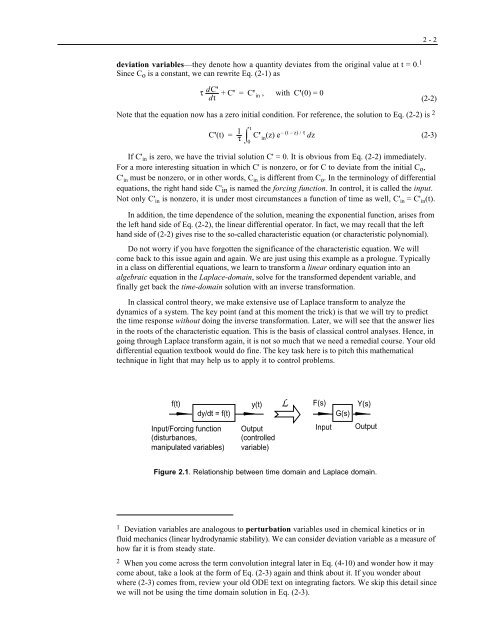Chemical Process Control a First Course with Matlab
Chemical Process Control a First Course with Matlab
Chemical Process Control a First Course with Matlab
Create successful ePaper yourself
Turn your PDF publications into a flip-book with our unique Google optimized e-Paper software.
2 - 2<br />
deviation variables—they denote how a quantity deviates from the original value at t = 0. 1<br />
Since C o is a constant, we can rewrite Eq. (2-1) as<br />
τ dC'<br />
dt<br />
+C' =C' in , <strong>with</strong> C'(0) = 0<br />
(2-2)<br />
Note that the equation now has a zero initial condition. For reference, the solution to Eq. (2-2) is 2<br />
C'(t) = 1 τ<br />
0<br />
t<br />
C' in<br />
(z) e –(t–z)/τ dz<br />
(2-3)<br />
If C' in is zero, we have the trivial solution C' = 0. It is obvious from Eq. (2-2) immediately.<br />
For a more interesting situation in which C' is nonzero, or for C to deviate from the initial C o ,<br />
C' in must be nonzero, or in other words, C in is different from C o . In the terminology of differential<br />
equations, the right hand side C' in is named the forcing function. In control, it is called the input.<br />
Not only C' in is nonzero, it is under most circumstances a function of time as well, C' in = C' in (t).<br />
In addition, the time dependence of the solution, meaning the exponential function, arises from<br />
the left hand side of Eq. (2-2), the linear differential operator. In fact, we may recall that the left<br />
hand side of (2-2) gives rise to the so-called characteristic equation (or characteristic polynomial).<br />
Do not worry if you have forgotten the significance of the characteristic equation. We will<br />
come back to this issue again and again. We are just using this example as a prologue. Typically<br />
in a class on differential equations, we learn to transform a linear ordinary equation into an<br />
algebraic equation in the Laplace-domain, solve for the transformed dependent variable, and<br />
finally get back the time-domain solution <strong>with</strong> an inverse transformation.<br />
In classical control theory, we make extensive use of Laplace transform to analyze the<br />
dynamics of a system. The key point (and at this moment the trick) is that we will try to predict<br />
the time response <strong>with</strong>out doing the inverse transformation. Later, we will see that the answer lies<br />
in the roots of the characteristic equation. This is the basis of classical control analyses. Hence, in<br />
going through Laplace transform again, it is not so much that we need a remedial course. Your old<br />
differential equation textbook would do fine. The key task here is to pitch this mathematical<br />
technique in light that may help us to apply it to control problems.<br />
f(t) y(t) F(s) Y(s)<br />
dy/dt = f(t)<br />
G(s)<br />
Input/Forcing function Output<br />
Input Output<br />
(disturbances,<br />
(controlled<br />
manipulated variables) variable)<br />
L<br />
Figure 2.1. Relationship between time domain and Laplace domain.<br />
1 Deviation variables are analogous to perturbation variables used in chemical kinetics or in<br />
fluid mechanics (linear hydrodynamic stability). We can consider deviation variable as a measure of<br />
how far it is from steady state.<br />
2 When you come across the term convolution integral later in Eq. (4-10) and wonder how it may<br />
come about, take a look at the form of Eq. (2-3) again and think about it. If you wonder about<br />
where (2-3) comes from, review your old ODE text on integrating factors. We skip this detail since<br />
we will not be using the time domain solution in Eq. (2-3).



